Toward Group Applications: A Critical Review of the Classification Strategies of Lithium-Ion Batteries
Abstract
:1. Introduction
2. Direct Measurement
2.1. Sorting Based on the Static Parameters of Power Batteries
2.2. Sorting Based on the Dynamic Parameters of Power Batteries
2.3. Sorting by Multiple Parameters
3. Sorting Method of Power Batteries Based on Model
3.1. Equivalent Circuit Model
3.2. Clustering Algorithm
- Initialize the clustering center or membership matrix U; set the number of clusters C and fuzzy index m; randomly initialize V (0); set the precision of convergence ε; let the number of iterations k = 0;
- Calculate the membership matrix U (k + 1);
- Calculate the clustering center V (k + 1), let k = k + 1.
3.3. Neural Network Algorithm
3.4. Statistical Methods
4. Sorting Method Based on Material Chemistry
5. Comparison and Prospect
6. Conclusions
Author Contributions
Funding
Conflicts of Interest
References
- Sun, G.; Chen, Y. Experimental study on the screening criteria of echelon use of returned power battery. Chin. J. Power Sources 2018, 42, 1818–1821. [Google Scholar]
- Neupert, S.; Kowal, J. Inhomogeneities in Battery Packs. World Electr. Veh. J. 2018, 9, 20. [Google Scholar] [CrossRef] [Green Version]
- Das, A.; Li, D.; Williams, D.K. Joining Technologies for Automotive Battery Systems Manufacturing. World Electr. Veh. J. 2018, 9, 22. [Google Scholar] [CrossRef] [Green Version]
- Jiya, I.N.; Gurusinghe, N.; Gouws, R. Combination of LiCs and EDLCs with Batteries: A New Paradigm of Hybrid Energy Storage for Application in EVs. World Electr. Veh. J. 2018, 9, 47. [Google Scholar] [CrossRef] [Green Version]
- Wang, J.-Y.; Sun, Z.-C.; Wei, X.-Z.; Dai, H.-F. Research on power battery cell classification method for electric vehicles. Chin. J. Power Sources 2012, 36, 94–98. [Google Scholar]
- Jla, F.-C.; Liu, Y. Group Scheme of Power Lithium Ion Battery. Guangzhou Chem. Ind. 2015, 43, 28–29. [Google Scholar]
- Dong, H.; Gou, L.; Gan, Y. Research status and trend of power lithium battery cascade utilization matching research. Metall. Autom. 2017, S2, 301–303. [Google Scholar]
- Ma, J.; Li, A.; Du, T.; Liu, F. Research Development on the Methods of Making Sets of Lithium-ion Battery. In Proceedings of the 19th Branch of the 14th Annual Conference of the China Association for Science and Technology: The Seminar on Charge and Discharge of Electric Vehicle, Shijiazhuang, China, 18 September 2012. [Google Scholar]
- Wang, L.; Xie, L.; Zhang, G.; He, X. Research progress in the consistency screening of Li-ion batteries. Energy Storage Sci. Technol. 2018, 7, 194–202. [Google Scholar]
- Yang, F. Inconformity of Li Battery Pack and Remedial Measures. Auto Electr. Parts 2014, 5, 37–40. [Google Scholar]
- An, F.; Zhang, J.; Huang, J. Production of lithium-ion battery and uniformity evolution analysis. Trans. Mater. Heat Treat. 2015, 36, 239–248. [Google Scholar]
- Feng, J.; Guo, J.; Wang, X.-H.; Duan, B.-J. Investigation of screening method for Li-MnO2 battery. Chin. J. Power Sources 2014, 38, 1249–1250+1275. [Google Scholar]
- Xiao, T.; Fan, Y.-F. The design of Bluetooth battery sorting system. Equip. Manuf. Technol. 2017, 3, 172–174. [Google Scholar]
- Yu, B. Analysis of the secondary battery detection and sorting system. Sci. Technol. Innov. Guide 2014, 11, 44. [Google Scholar]
- Ro, H. Sorting Machine of Battery Cell and Sorting Method Thereof. U.S. Patent 9,209,496, 8 December 2015. [Google Scholar]
- Zhou, Y. Design for formalizing and seperating system of lithium battery. J. Harbin Bearing 2014, 35, 106–107. [Google Scholar]
- Li, P. Battery AC internal resistance automatic sorting system. J. Harbin Univ. Sci. Technol. 1999, 1, 3–5. [Google Scholar]
- Li, S.; Liu, H.; Wan, Q. Automatic sorting device for secondary battery internal resistance detection. Users Instrum. 2005, 4, 45–47. [Google Scholar]
- Shen, J.; Qu, Y.; Li, F. A New Lithium-ion Battery Separator Based on PLC. Electron. Sci. Technol. 2015, 28, 14–17+21. [Google Scholar]
- Yu, J.; Wen, Y.-M.; Zhan, K.-Y.; Dong, W.-H.; Kong, M.; Zeng, C.-M. Test and separation system for rechargeable battery based on network platform. Chin. J. Power Sources 2007, 6, 478–480+487. [Google Scholar]
- Zhou, J.; Liu, S.; He, K.; Zhu, Y. Fast sorting system of battery based on FPGA. Chin. J. Power Sources 2014, 38, 1866–1868. [Google Scholar]
- Han, W.; Zhang, W.; Wang, L.; Li, Z.-Y.; Liu, G.-Q. New technology in automobile power battery group assembly—According to method of volt-ampere characteristic curve of sorting batteries. Chin. J. Power Sources 2014, 38, 2225–2227. [Google Scholar]
- Wang, S.; Yin, Z.; Zheng, Z.; Wang, Y.; Zou, H.; Yan, Y. A Sorting Method for Retired Battery modules Based on Voltage Curves. In Proceedings of the CSEE, Barcelona, Spain, 10–12 June 2020. [Google Scholar]
- Li, J.; Wu, M.; Liu, Y. Research of Li-ion battery intelligent classifying system based on charge and discharge curve. Chin. J. Power Sources 2011, 35, 912–914. [Google Scholar]
- Du, C.; Luo, D.; Zhang, C. Study on screening method of lithium ion power battery. Chin. J. Power Sources 2017, 41, 977–980. [Google Scholar]
- Li, X.; Qi, J. Research on single battery voltage unbalance in storage battery. Guizhou Electr. Power Technol. 2014, 17, 54–55+45. [Google Scholar]
- Zeng, Y.; Yang, Y.; He, Z. Lead-acid Battery Automatic Grouping System Based on Graph Cuts. Electr. Power Compon. Syst. 2016, 44, 450–458. [Google Scholar] [CrossRef]
- Wang, L.; Wang, W.; Wang, Z.; Zhang, Y.; Liu, S. Study on inconsistency of lithium titanate battery in rail transportation. Chin. J. Power Sources 2017, 41, 195–197. [Google Scholar]
- Li, Y.; Wang, Y.-W.; Zhang, H.-C.; Zhang, N. Investigation of sorting with dynamic state of charge of lithium-iron-phosphate power battery. J. Jilin Univ. 2011, 41, 331–333. [Google Scholar]
- Kim, J.-H.; Shin, J.-W.; Jeon, C.-Y. Screening Process of Li-ion Series Battery Pack for Improved Voltage/SOC Balancing. In Proceedings of the 2010 International Power Electronics Conference, Sapporo, Japan, 21–24 June 2010. [Google Scholar]
- Fan, M.-Q.; Liao, W.-L.; Wu, B.-R.; Chen, H.; Zhu, L.; Jian, X.-Y.; Liu, M.-Y. Study of consistency and selected method of Ni-MH battery. Chin. J. Power Sources 2005, 6, 361–364. [Google Scholar]
- Li, X.; Wang, T.; Pei, L. A comparative study of sorting methods for lithium-ion batteries. In Proceedings of the 2014 IEEE Conference and Expo Transportation Electrification Asia-Pacific (ITEC Asia-Pacific), Beijing, China, 31 August–3 September 2014; pp. 1–6. [Google Scholar]
- Muhammad, M.; Attidekou, P.S.; Ahmeid, M. Sorting of Spent Electric Vehicle Batteries for Second Life Application. In Proceedings of the 2019 IEEE 7th International Conference on Smart Energy Grid Engineering (SEGE), Oshawa, ON, Canada, 12–14 August 2019; pp. 325–329. [Google Scholar]
- Zhou, Z.; Duan, B.; Kang, Y.; Shang, Y.; Cui, N.; Chang, L.; Zhang, C. An efficient screening method for retired lithium-ion batteries based on support vector machine. J. Clean. Prod. 2020, 267, 121882. [Google Scholar] [CrossRef]
- Li, J.; Wang, Y.; Tan, X. Research on the Classification Method for the Secondary Uses of Retired Lithium-ion Traction Batteries. Energy Procedia 2017, 105, 2843–2849. [Google Scholar] [CrossRef]
- Zhang, G. Research on Reliability for Commercial 18650 Lithiumion Battery. Ph.D. Thesis, Tsinghua University, Beijing, China, 2017. [Google Scholar]
- He, X.; Zhang, G.; Feng, X.; Wang, X.; Tian, G.; Ouyang, M. A facile consistency screening approach to select cells with better performance consistency for commercial 18650 lithium ion cells. Int. Electrochem. Sci. 2017, 12, 1023–1025. [Google Scholar]
- Zhang, W.-H.; Pei, F.; Liu, P. Electrochemical impedance analysis of LiFePO4/C batteries in cycling process. Chin. J. Power Sources 2015, 39, 54–57. [Google Scholar]
- Li, X.; Lan, X.; Tang, Q. Research on Uniform Sorting Method for Automotive Lithium-ion Batteries. J. Power Supply 2020. Available online: http://kns.cnki.net/kcms/detail/12.1420.TM.20191118.1000.010.html (accessed on 18 November 2019).
- Chen, S.; Zeng, Z. Research on the automatic assembly plan of power lithium battery. Mech. Eng. Autom. 2018, 5, 142–144. [Google Scholar]
- Yan, Y.; Gu, Z.; Huang, H.; Lu, C. Selecting method on secondary use of power Li-ion battery. Battery Bimon. 2018, 48, 414–416. [Google Scholar]
- Wen, C.-G.; Wang, Y.-Y.; Feng, W.-F.; Ma, W.-T. Study of separation process of Li-battery based on multivariable data fitting. Chin. J. Power Sources 2018, 42, 1480–1482. [Google Scholar]
- Cai, M.; Chen, W.-J.; Xu, J.-B.; Tan, X.-J. Research on classification method of secondary use of retired LiFePO4 batteries. Chin. J. Power Sources 2019, 43, 781–784. [Google Scholar]
- Kim, J.; Shin, J.; Chun, C. Stable configuration of a Li-ion series battery pack based on a screeing process for improved voly-age /SOC balancing. IEEE Trans. Power Electron. 2012, 27, 411–424. [Google Scholar] [CrossRef]
- Xu, Y.; Yu, L.-M.; Gao, Q. Power battery combination method of electric vehicle based on capacity maximization. Chin. J. Power Sources 2019, 43, 91–94. [Google Scholar]
- Ke, L.; Wang, Y.; Hu, Y. Safety Design of Power Bank Based on Standard. Autom. Inf. Eng. 2015, 36, 45–48. [Google Scholar]
- Shi, J.; Li, H.; Qiu, H. Research on Emergency Energy Storage Equipment Technology for Waste Power Battery Ladder Utilization. Automob. Appl. Technol. 2020, 10, 4–7. [Google Scholar]
- Wu, F.; Wu, S.; Pei, F. Research on the grouping and management technology of lithium iron phosphate batteries for cascade utilization. Electr. Appl. 2016, 35, 64–68. [Google Scholar]
- Xue, H.; Tao, Y.-B.; Yang, B.; Wu, F.-B.; Sun, -L. Screening method of retired LiFePO4 batteries based on aging mechanism analysis. Chin. J. Power Sources 2020, 44, 660–665. [Google Scholar]
- Bai, K.; Li, N.; Fan, M. Research on the Technical Roadmap for Engineering Application of Large-Scale Echelon Use Battery Energy Storage System. North China Electr. Power 2017, 3, 39–45. [Google Scholar]
- Li, X.-L.; Chen, Q.; Guan, Y. Test characteristic analyse of second use of lithium-ion power batteries. Chin. J. Power Sources 2013, 37, 1940–1943. [Google Scholar]
- Qin, J. Application and Distribution of Lithium-ion Battery. Value Eng. 2013, 32, 297–299. [Google Scholar]
- Wang, X.-W.; Guo, Z.; Zhang, G.-J.; Zhang, C.-S. Study on packing technology for different types of lithium-ion batteries. Chin. J. Power Sources 2014, 38, 1437–1439. [Google Scholar]
- Zhang, H.; Wang, D. Auto Testing and Sorting System of the Battery’s Characteristics Base on the IC Card Battery Tray. Equip. Electron. Prod. Manuf. 2010, 39, 21–24+34. [Google Scholar]
- Liao, Y.-W. Design for Smart Distribution Group System of Battery. J. Hubei Univ. Arts Sci. 2009, 30, 20–23. [Google Scholar]
- Guo, Z. About the lead-acid battery matching. China Bicycl. 2009, 2, 33–36. [Google Scholar]
- Gui, C.-Q. Matched group of VRLA battery used for electric bicycle. Battery Bimon. 2005, 3, 53–54. [Google Scholar]
- Li, N.; Bai, K.; Wang, K.-R. Performance and prediction of retired electric vehicle battery recycling in electric energy storage condition. Chin. J. Power Sources 2019, 43, 445–449. [Google Scholar]
- Li, J.; Li, Y.; Lyu, C.; Zhao, W.; Zhou, J. Key Technology and Research Status of Cascaded Utilization in Decommissioned Power Battery. Autom. Electr. Power Syst. 2020, 44, 172–184. [Google Scholar]
- Zhao, M.; Li, N.; Yuan, J. Evaluation Index of Consistency of Internal Resistance of Echelon-use Lithium Battery. Sino-Glob. Energy 2018, 23, 86–92. [Google Scholar]
- Mi, J.-F.; Fan, M.-S.; Wang, H. Performance study of retired power lithium iron phosphate batteries. Chin. J. Power Sources 2019, 43, 217–220. [Google Scholar]
- Li, Z.; Dong, H.-C. Feasibility study of secondary utilization of retired power lithium-ion battery. Chin. J. Power Sources 2016, 8, 1582–1584. [Google Scholar]
- Duan, S.-H.; Jia, Q.-R.; Dai, B.; Liu, X.-J. Screening method for self-discharging of lithium iron phosphate Li-ion battery. Battery Bimon. 2015, 2, 44–47. [Google Scholar]
- Yang, G.; Cui, Y.; Zhou, J. Research on the selecting methods for Li-ion cells. Chin. Battery Ind. 2009, 14, 152–154. [Google Scholar]
- An, F.; Zhao, H.; Li, P. Self-discharge rates in cells have a critical effect on the cycle life of parallel lithium-ion batteries. RSC Adv. 2018, 8, 30802–30812. [Google Scholar] [CrossRef] [Green Version]
- Liao, Q.; Mu, M.; Zhao, S. Performance assessment and classification of retired lithium ion battery from electric vehicles for energy storage. Int. J. Hydrogen Energy 2017, 42, 18817–18823. [Google Scholar] [CrossRef]
- Chen, H.; Wu, B.-R.; Zhu, L. Selection and performance of Ni/MH power batteries. Battery Bimon. 2004, 34, 99–101. [Google Scholar]
- You, L.-R.; Zhang, J.-G.; Wang, Y. Classification method of Ni-MH battery based on Data-Fusion theory. Chin. J. Power Sources 2000, 24, 149–152. [Google Scholar]
- Huang, J. Consistency and sorting method of lithium-ion batteries for electric vehicles. Institute of Energy Storage Engineering of the Chemical Industry and Engineering Society of China. In Proceedings of the Abstract Collection of the First National Energy Storage Science and Technology Conference, Kanazawa, Japan, 27–31 July 2014. [Google Scholar]
- An, F.; Huang, J.; Wang, C. Cell sorting for parallel lithium-ion battery systems: Evaluation based on an electric circuit model. J. Energy Storage 2016, 6, 195–203. [Google Scholar] [CrossRef]
- Duo, Z.; Li, G. Study on method of battery classification with wormform recognition ability. Chin. J. Power Sources 1998, 4, 38–42. [Google Scholar]
- Li, R.; Wu, J.; Wang, H. Classification of battery consistency based on multi-spectral method. Chin. J. Power Sources 2010, 10, 7. [Google Scholar]
- Haiying, W.; Kai, D.; Gechen, L. Research on the consistency of the power battery based on multi-points impedance spectrum. In Proceedings of the International Forum on Strategic Technology 2010, Ulsan, Korea, 13–15 October 2010; pp. 1–4. [Google Scholar]
- Ye, M.; Song, X.; Xiong, R. A Novel Dynamic Performance Analysis and Evaluation Model of Series-Parallel Connected Battery Pack for Electric Vehicles. IEEE Access 2019, 7, 14256–14265. [Google Scholar] [CrossRef]
- Wang, Q.; Qi, W. Study on influence of sorting parameters to lithium-ion battery pack life-cycles based on cell consistency. Int. J. Electr. Hybrid Veh. 2018, 10, 223–235. [Google Scholar] [CrossRef]
- Shen, J.; Tang, Y.; Li, Y. A new method based on unsupervised clustering for lithium-ion battery classification. Comput. Appl. Chem. 2007, 24, 305–308. [Google Scholar]
- Li, X. A screening method for the consistency of lithium-ion batteries. Today Electron. 2018, 3, 52–53. [Google Scholar]
- Li, W.; Chen, S.; Peng, X. A Comprehensive Approach for the Clustering of Similar-Performance Cells for the Design of a Lithium-Ion Battery Module for Electric Vehicles. Engineering 2019, 5, 795–802. [Google Scholar] [CrossRef]
- Yang, H.-Y.; Chen, J.-H.; Tang, Z.-M. Screening decommissioned power batteries based on K-means algorithm and genetic algorithm. Chin. J. Power Sources 2019, 43, 2001–2004. [Google Scholar]
- Yang, Y.; Gao, M.; He, Z. A Robust Battery Grouping Method Based on a Characteristic Distribution Model. Energies 2017, 10, 1035. [Google Scholar] [CrossRef] [Green Version]
- Cai, D.; Chen, P.; Tang, W.; You, L.; Peng, T. Core Sorting of Lithium Battery based on Improved ISODATA Algorithm. In Proceedings of the 2019 Chinese Automation Congress (CAC), Hangzhou, China, 22–24 November 2019; pp. 3958–3963. [Google Scholar] [CrossRef]
- Pallonetto, F.; Galvani, M.; Torti, A. A Framework for Analysis and Expansion of Public Charging Infrastructure under Fast Penetration of Electric Vehicles. World Electr. Veh. J. 2020, 11, 18. [Google Scholar] [CrossRef] [Green Version]
- Xu, G.; Chen, H.; Gong, M. A clustering method based on cascade utilization of battery in series. Electr. Technol. 2017, 1, 37–41. [Google Scholar]
- Li, X.; Song, K.; Wei, G.; Lu, R.; Zhu, C. A Novel Grouping Method for Lithium Iron Phosphate Batteries Based on a Fractional Joint Kalman Filter and a New Modified K-Means Clustering Algorithm. Energies 2015, 8, 7703–7728. [Google Scholar] [CrossRef] [Green Version]
- Jiao, D.-S.; Kang, X.-N.; Pan, M.-Y.; Li, X.-L.; Chi, Z.-J. A consistency evaluation method for battery capacity. Chin. J. Power Sources 2016, 40, 1429–1433. [Google Scholar]
- Yao, J.; Zhou, Y.; Li, R.; Li, S. Research on multistage sorting method of zinc silver power battery based on LS-SVM and FCM. J. Nat. Sci. Heilongjiang Univ. 2018, 35, 484–492. [Google Scholar]
- Wang, D.; Yang, F.; Gan, L. Fuzzy Prediction of Power Lithium Ion Battery State of Function Based on the Fuzzy c-Means Clustering Algorithm. World Electr. Veh. J. 2019, 10, 1. [Google Scholar] [CrossRef] [Green Version]
- Lyu, C.; Song, Y.; Wang, L. A new method for lithium-ion battery uniformity sorting based on internal criteria. J. Energy Storage 2019, 25, 100885. [Google Scholar] [CrossRef]
- Wang, D.-M.; Feng, W.-F.; Bai, H.-Y.; Liu, Z.-Z. Research on clustering algorithm based on voltage platform for cells classification. Chin. J. Power Sources 2016, 40, 994–996+1007. [Google Scholar]
- Rui, Z.; Yongqin, Z.; Ran, L. A battery sorting scheme based on fuzzy C-mean clustering, taking advantage of the flatness of discharge voltage curve. Automot. Eng. 2017, 39, 864. [Google Scholar]
- Jones, B.L.; Smith, P.; Clifton, J.M. Battery Testing and Classification. U.S. Patent 6,526,361, 25 February 2003. [Google Scholar]
- Zhi, Y.; Ran, L. Research for classification method of battery based on state of health. Int. J. Secur. Appl. 2016, 10, 47–54. [Google Scholar]
- Xin, C.; Zhao, F.; Wu, Y. Research on automatic matching model of power battery. In International Conference on Mechanical Design; Springer: Berlin/Heidelberg, Germany, 2019; pp. 749–759. [Google Scholar]
- Fu, Y.; Quan, S. Improved fuzzy C-means clustering algorithm and application of lithium battery assembly. J. Henan Univ. Sci. Technol. 2017, 38, 43–48+118. [Google Scholar]
- Wang, Q.; Cheng, X.Z. A new algorithm for a fast testing and sorting system applied to battery clustering. In Proceedings of the 2017 6th International Conference on Clean Electrical Power (ICCEP), Liguria, Italy, 27–29 June 2017. [Google Scholar]
- Wang, L.; Liu, J.; Ye, Q. Sorting method of lithium-ion batteriesinmass production. IOP Conf. Ser. Earth Environ. 2020, 512, 012127. [Google Scholar] [CrossRef]
- Li, R.; Yao, J.; Zhou, Y. Study on sorting method of zinc silver battery based on multi-step FCM clustering algorithm. IEICE Electron. Express 2019, 16, 20190120. [Google Scholar] [CrossRef] [Green Version]
- Li, R.; Xu, S.; Zhou, Y. Toward Group Applications of Zinc-Silver Battery: A Classification Strategy Based on PSO-LSSVM. IEEE Access 2020, 8, 4745–4753. [Google Scholar] [CrossRef]
- Guo, L.; Liu, G.W. Research of lithium-ion battery sorting method based on fuzzy C-means algorithm. Adv. Mater. Res. Trans. Tech. Publ. 2012, 354, 983–988. [Google Scholar] [CrossRef]
- Zhao, Y.-F.; Feng, G.-B.; Geng, B.; Liu, J.; Chen, X.-J. Research of dynamic characteristic match of lead-acid batteries. Chin. J. Power Sources 2007, 10, 808–810. [Google Scholar]
- Yin, J.; Wang, W.; Yuan, X.; Xu, W.; Li, X.; He, Z. Study on Rapid Evaluation and Sorting Method of Cascade Lithium Battery. J. Chongqing Univ. Technol. 2020, 34, 15–23. [Google Scholar]
- He, Z.; Gao, M.; Ma, G. Battery Grouping with Time Series Clustering Based on Affinity Propagation. Energies 2016, 9, 561. [Google Scholar] [CrossRef]
- Xu, Z.; Wang, J.; Lund, P.D. A novel clustering algorithm for grouping and cascade utilization of retired Li-ion batteries. J. Energy Storage 2020, 29. [Google Scholar] [CrossRef]
- Bai, X.; Tan, J.; Wang, X. Study on distributed lithium-ion power battery grouping scheme for efficiency and consistency improvement. J. Clean. Prod. 2019, 233, 429–445. [Google Scholar] [CrossRef]
- Lee, H.; Kang, C.; Park, Y. Study on Power Management Strategy of HEV using Dynamic Programming. World Electr. Veh. J. 2016, 8, 274. [Google Scholar] [CrossRef] [Green Version]
- Wu, Y.-L.; Li, G.-C.; Chen, S.-L. The Application of BP Nerual Network in Battery-sorting. J. Harbin Univ. Sci. Technol. 2001, 5, 10–13. [Google Scholar]
- He, F.; Shen, W.X.; Song, Q. Clustering LiFePO4 cells for battery pack based on neural network in EVs. In Proceedings of the 2014 IEEE Conference and Expo Transportation Electrification Asia-Pacific (ITEC Asia-Pacific), Beijing, China, 31 August–3 September 2014. [Google Scholar]
- Xia, B.; Yang, Y.; Zhou, J. Using Self Organizing Maps to Achieve Lithium-Ion Battery Cells Multi-Parameter Sorting Based on Principle Components Analysis. Energies 2019, 12, 2980. [Google Scholar] [CrossRef] [Green Version]
- Fang, K.; Chen, S.; Mu, D. Investigation of nickel–metal hydride battery sorting based on charging thermal behavior. J. Power Sources 2013, 224, 120–124. [Google Scholar] [CrossRef]
- Paolo, R.; Leonardo, F.; Adriano, M.; Matteo, C.; Sauro, L.; Luca, F.; Paolo, B.; Roberto, I. Selection of Lithium Cells for EV Battery Pack Using Self-Organizing Maps. Automot. Saf. Energy Technol. 2011, 2, 157–164. [Google Scholar]
- He, F.; Shen, W.; Song, Q. Self-organising map based classification of LiFePO4 cells for battery pack in EVs. Int. J. Veh. Des. 2015, 69, 151–167. [Google Scholar] [CrossRef]
- Xu, Y. Capacity Estimation and Cascade Utilization Method of Retired Lithium Ion Batteries. J. Nanoelectron. Optoelectron. 2017, 12, 803–807. [Google Scholar] [CrossRef]
- Lai, X.; Qiao, D.; Zheng, Y. A Novel Screening Method Based on a Partially Discharging Curve Using a Genetic Algorithm and Back-Propagation Model for the Cascade Utilization of Retired Lithium-Ion Batteries. Electronics 2018, 7, 399. [Google Scholar] [CrossRef] [Green Version]
- Chen, Z.; Guo, N.; Li, X. Battery Pack Grouping and Capacity Improvement for Electric Vehicles Based on a Genetic Algorithm. Energies 2017, 10, 439. [Google Scholar] [CrossRef] [Green Version]
- Shen, S.; Sadoughi, M.; Li, M. Deep convolutional neural networks with ensemble learning and transfer learning for capacity estimation of lithium-ion batteries. Appl. Energy 2020. [Google Scholar] [CrossRef]
- Shen, S.; Sadoughi, M.; Chen, X. A deep learning method for online capacity estimation of lithium-ion batteries. J. Energy Storage 2019, 25, 100817. [Google Scholar] [CrossRef]
- Song, X.; Yang, F.; Wang, D. Combined CNN-LSTM Network for State-of-Charge Estimation of Lithium-Ion Batteries. IEEE Access 2019, 7, 88894–88902. [Google Scholar] [CrossRef]
- Chen, C.; Xiong, R.; Yang, R. State-of-charge estimation of lithium-ion battery using an improved neural network model and extended Kalman filter. J. Clean. Prod. 2019, 234, 1153–1164. [Google Scholar] [CrossRef]
- Choi, Y.; Ryu, S.; Park, K. Machine Learning-Based Lithium-Ion Battery Capacity Estimation Exploiting Multi-Channel Charging Profiles. IEEE Access 2019, 7, 75143–75152. [Google Scholar] [CrossRef]
- Hong, J.; Wang, Z.; Chen, W. Synchronous multi-parameter prediction of battery systems on electric vehicles using long short-term memory networks. Appl. Energy 2019, 254, 75143–75152. [Google Scholar] [CrossRef]
- Bian, C.; He, H.; Yang, S. Stacked bidirectional long short-term memory networks for state-of-charge estimation of lithium-ion batteries. Energy 2020, 191, 116538. [Google Scholar] [CrossRef]
- Xu, W.; Xiao, L.; Zhu, Z. (Eds.) Computer Engineering and Technology; Springer: Singapore, 2019. [Google Scholar]
- Khumprom, P.; Yodo, N. A Data-Driven Predictive Prognostic Model for Lithium-ion Batteries based on a Deep Learning Algorithm. Energies 2019, 12, 660. [Google Scholar] [CrossRef] [Green Version]
- Ren, L.; Zhao, L.; Hong, S. Remaining Useful Life Prediction for Lithium-Ion Battery: A Deep Learning Approach. IEEE Access 2018, 50587–50598. [Google Scholar] [CrossRef]
- Patil, M.A.; Tagade, P.; Hariharan, K.S. A novel multistage Support Vector Machine based approach for Li ion battery remaining useful life estimation. Appl. Energy 2015, 159, 285–297. [Google Scholar] [CrossRef]
- Lucian, U.; Mihai, V.; Micea, G. Online state of health prediction method for lithium-ion batteries, based on gated recurrent unit neural networks. Int. J. Energy Res. 2020, 44. [Google Scholar] [CrossRef]
- Kim, M.; Chun, H.; Kim, J. Data-efficient parameter identification of electrochemical lithium-ion battery model using deep Bayesian harmony search. Appl. Energy 2019, 254, 113644. [Google Scholar] [CrossRef]
- Tagade, P.; Hariharan, K.S.; Ramachandran, S. Deep Gaussian process regression for lithium-ion battery health prognosis and degradation mode diagnosis. J. Power Sources 2020, 445, 227281. [Google Scholar] [CrossRef]
- Zhang, C.; Chen, Z. Analysis of Power Battery Pack Process Based on Statistical Model. In Proceedings of the 13th China Annual Conference on System Simulation Technology and Its Application, Huangshan, China, 3–7 August 2011. [Google Scholar]
- Li, R.; Wu, J.; Fu, H. Lithium iron phosphate battery sorting research based on fuzzy clustering analysis. ICIC Express Lett. Part B Appl. Int. J. Res. Surv. 2013, 4, 943–949. [Google Scholar]
- Chen, Y.-H.; Wu, W.-J.; Liu, H.-W.; Zhang, Z.-Z. Study on Sorting Technology for Lithium-ion Power Battery of Electric Vehicle. J. Hunan Univ. 2016, 43, 23–31. [Google Scholar]
- Duo, Z.-H.; Li, G.-C.; Zhang, D.-L. A Fast Algorithm Based on Curve Recognition for Cells Classfication. J. Harbin Univ. Sci. Technol. 2001, 4, 52–56. [Google Scholar]
- Cocaña-Fernández, A.; Ranilla, J.; Gil-Pita, R. Energy-conscious fuzzy rule-based classifiers for battery operated embedded devices. In Proceedings of the 2017 IEEE International Conference on Fuzzy Systems (FUZZ-IEEE), Naples, Italy, 9–12 July 2017. [Google Scholar]
- Cheng, D.; Chen, B.-G.; Zhang, J.-Y. Research on battery automatic sorting and grouping system. Chin. J. Power Sources 2018, 42, 981–982+1002. [Google Scholar]
- Ye, W.-J.; Hu, Z. Study on combination method of power battery. Chin. J. Power Sources 2012. Available online: http://en.cnki.com.cn/Article_en/CJFDTOTAL-DYJS201211027.htm (accessed on 29 August 2020).
- Li, W.; Liu, S.; He, Z. Technical Difficulties Analysis of Multi-step Utilization of Power Battery. Automob. Appl. Technol. 2018, 22, 11–13. [Google Scholar]
- Zheng, F.-D.; Jiang, J.-C.; Sun, B.-X. Study of synthesized performance evaluation method of power battery based on the target of matching battery packs. Syst. Eng. Theory Pract. 2015, 35, 528–536. [Google Scholar]
- Liu, N.; Tang, X.; Duan, S.; Zhang, J. Capacity Optimization Method for PV-based Battery Swapping Stations Considering Second-use of Electric Vehicle Batteries. Proc. CSEE 2013, 33, 34–44. [Google Scholar]
- Wang, X.; Gao, C.; Sun, M. Probabilistic Prediction Algorithm for Cycle Life of Energy Storage in Lithium Battery. World Electr. Veh. J. 2019, 10, 7. [Google Scholar] [CrossRef] [Green Version]
- Diao, W.; Jiang, J.; Liang, H. Flexible Grouping for Enhanced Energy Utilization Efficiency in Battery Energy Storage Systems. Energies 2016, 9, 498. [Google Scholar] [CrossRef] [Green Version]
- Jiang, Y.; Jiang, J.; Zhang, C.; Zhang, W.; Gao, Y.; Guo, Q. Recognition of battery aging variations for LiFePO4 batteries in 2nd use applications combining incremental capacity analysis and statistical approaches. J. Power Sources 2017, 360, 180–188. [Google Scholar] [CrossRef]
- Li, R.; Wu, J.F.; Wang, H.Y. Reliability assessment and failure analysis of lithium iron phosphate batteries. Inf. Sci. 2014, 259, 359–368. [Google Scholar] [CrossRef]
- Zheng, Z.; Zhao, G.; Jin, Y.; Zhao, Z.; Gao, J. The Reutilization Screening of Retired Electric Vehicle Lithium-Ion Battery Based on Coulombic Efficiency. Trans. China Electrotech. Soc. 2019, 34, 388–395. [Google Scholar]
- Uddin, K.; Perera, S.; Widanage, W.D. Characterising Li-ion battery degradation through the identification of perturbations in electrochemical battery models. World Electr. Veh. J. 2015, 7, 76–84. [Google Scholar] [CrossRef] [Green Version]
- Podias, A.; Pfrang, A.; Persio, F.D. Sustainability Assessment of Second Use Applications of Automotive Batteries: Ageing of Li-Ion Battery Cells in Automotive and Grid-Scale Applications. World Electr. Veh. J. 2018, 9, 24. [Google Scholar] [CrossRef] [Green Version]
- Chun, H.; Kim, J.; Han, S. Parameter identification of an electrochemical lithium-ion battery model with convolutional neural network. IFAC-PapersOnLine 2019, 52, 129–134. [Google Scholar] [CrossRef]
- Ran, A.; Chen, S.; Zhang, S. A gradient screening approach for retired lithium-ion batteries based on X-ray computed tomography images. RSC Adv. 2020, 10. [Google Scholar] [CrossRef]
- Felder, M.P.; Götze, J. State of charge classification for lithium-ion batteries using impedance based features. Adv. Radio Sci. 2017, 15, 93–97. [Google Scholar] [CrossRef] [Green Version]
- Chen, H.; Shen, J. A degradation-based sorting method for lithium-ion battery reuse. PLoS ONE 2017, 12. [Google Scholar] [CrossRef] [PubMed]
- Xu, M. Implementing Battery Consistency Function Based on SQL Database. Mar. Electr. Electron. Eng. 2012, 32, 92–95. [Google Scholar]

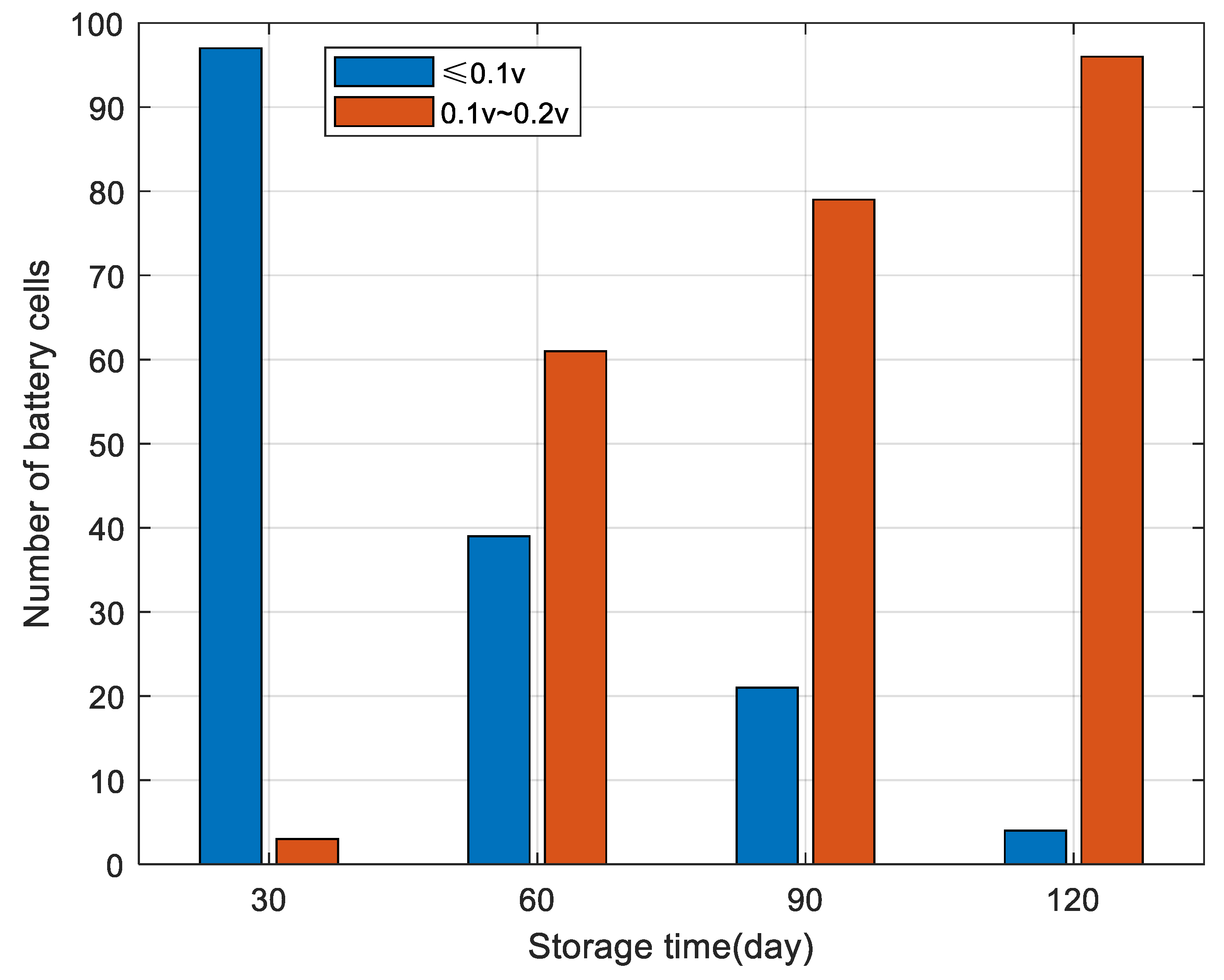
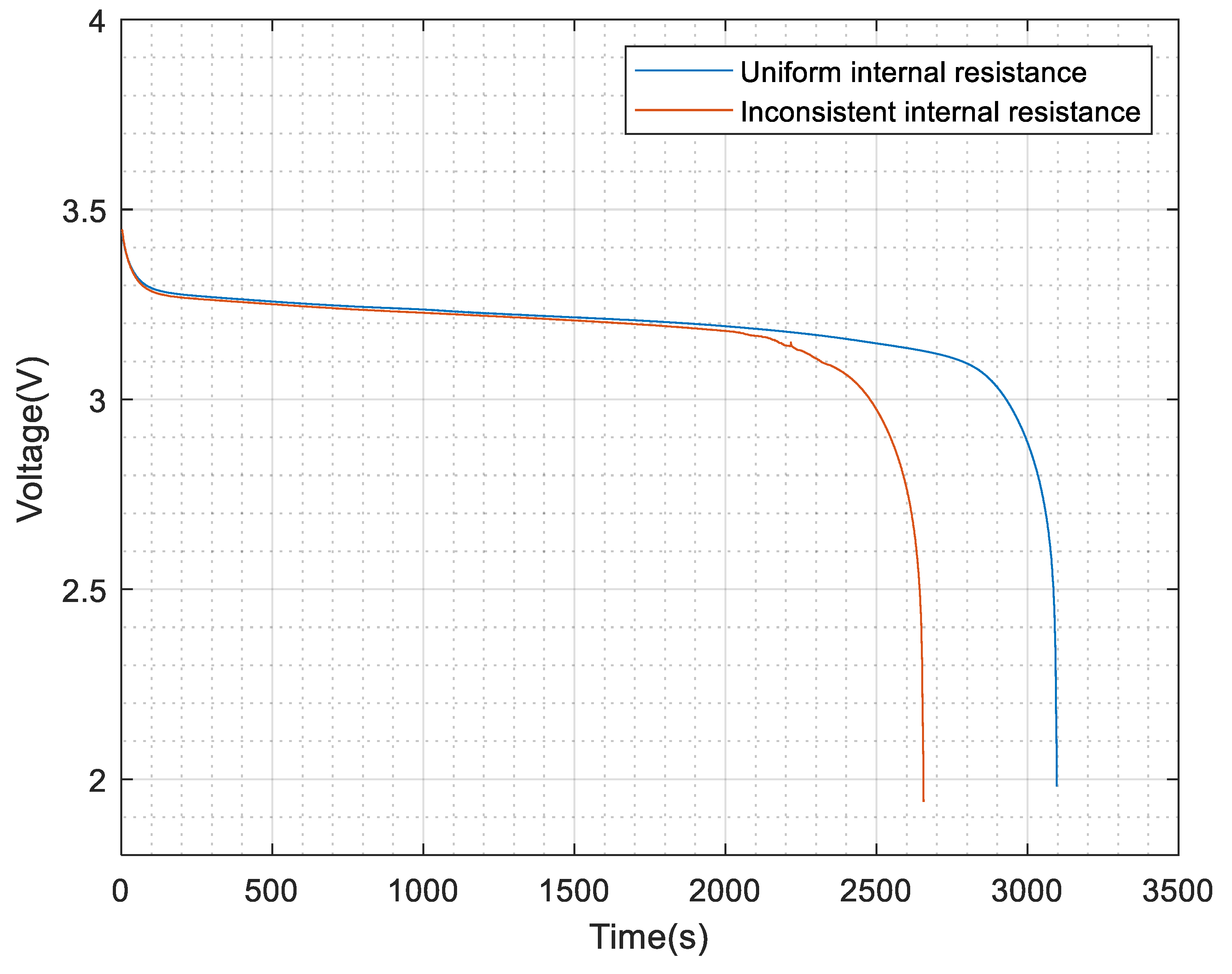

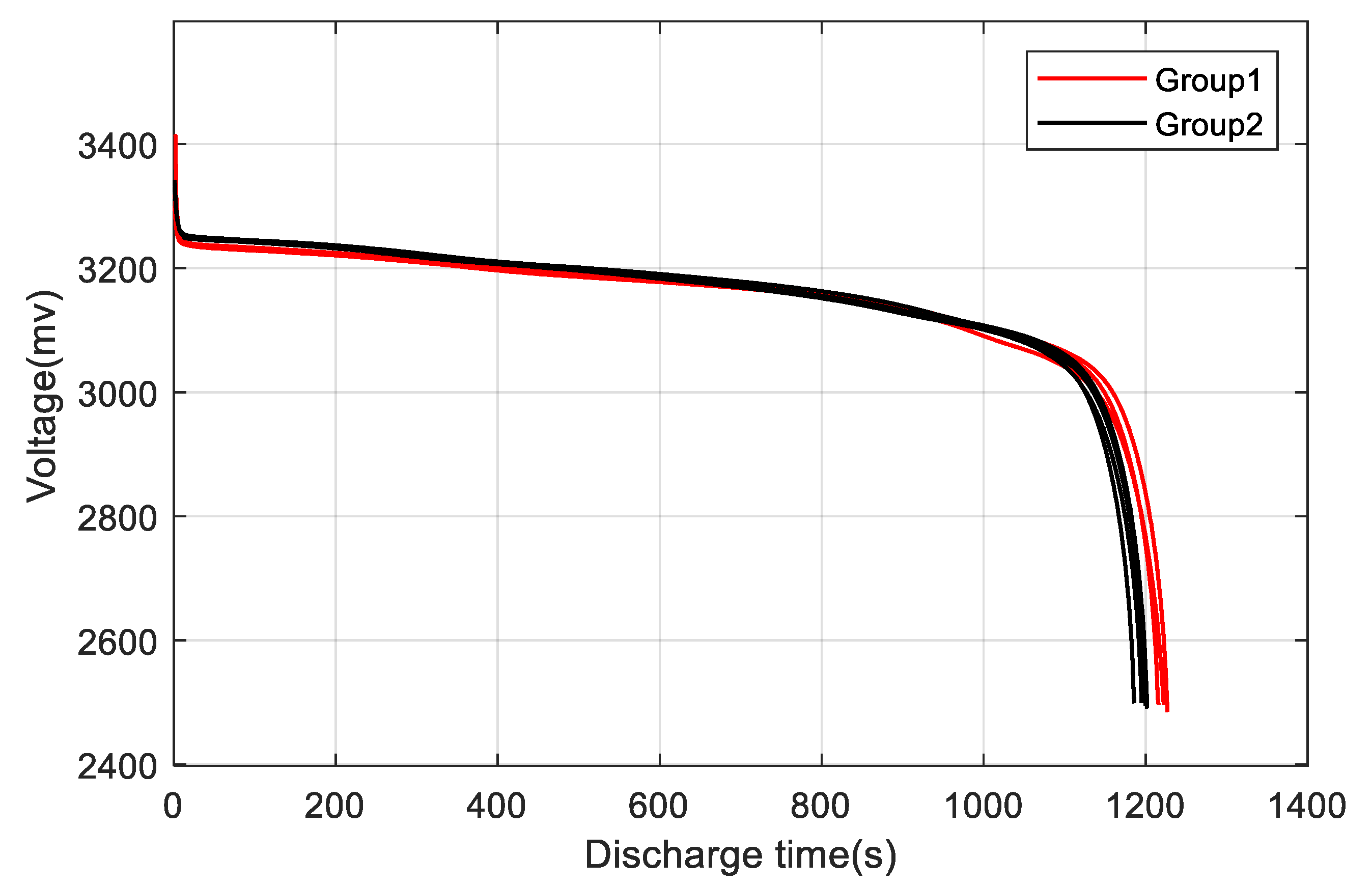
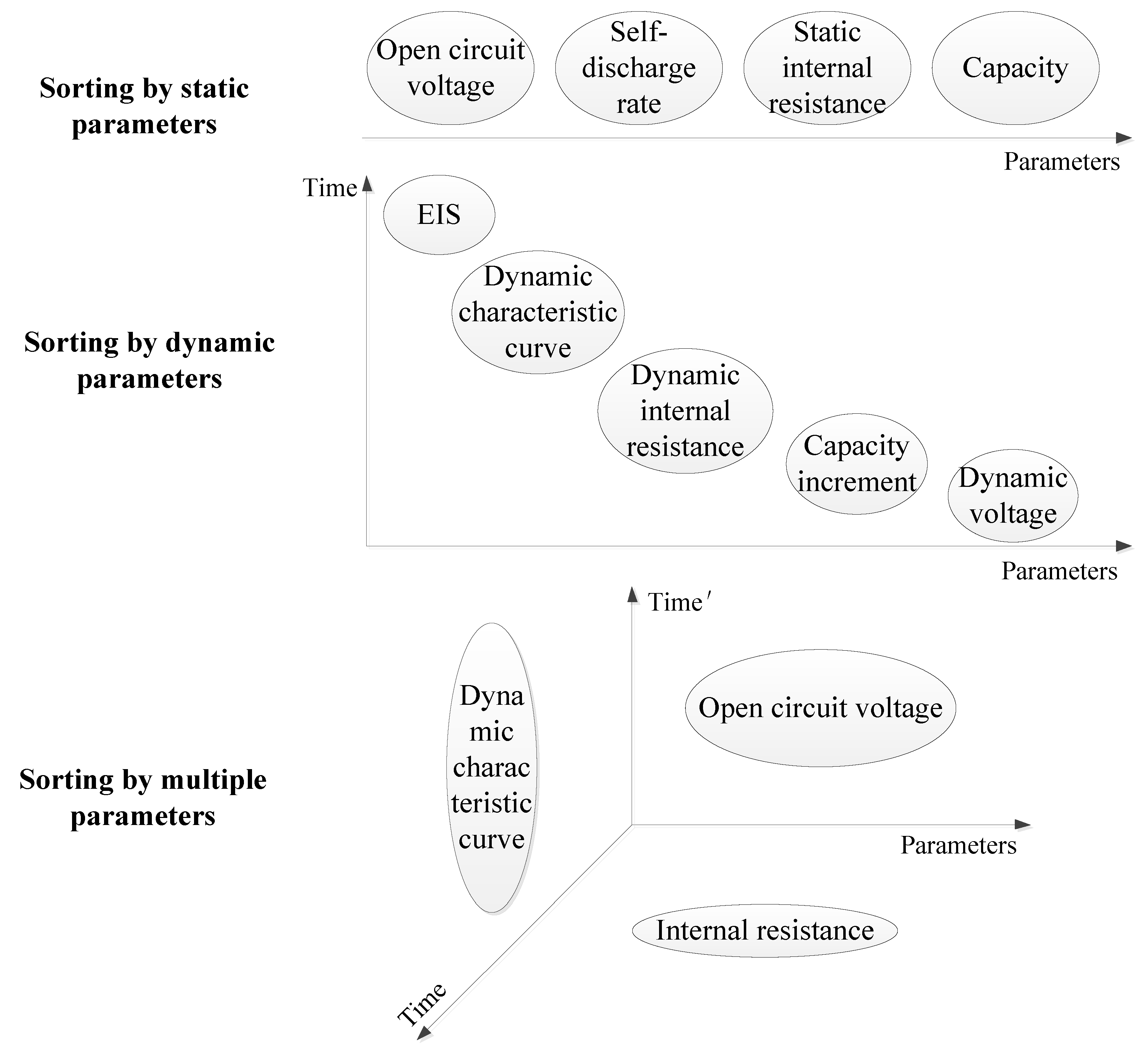

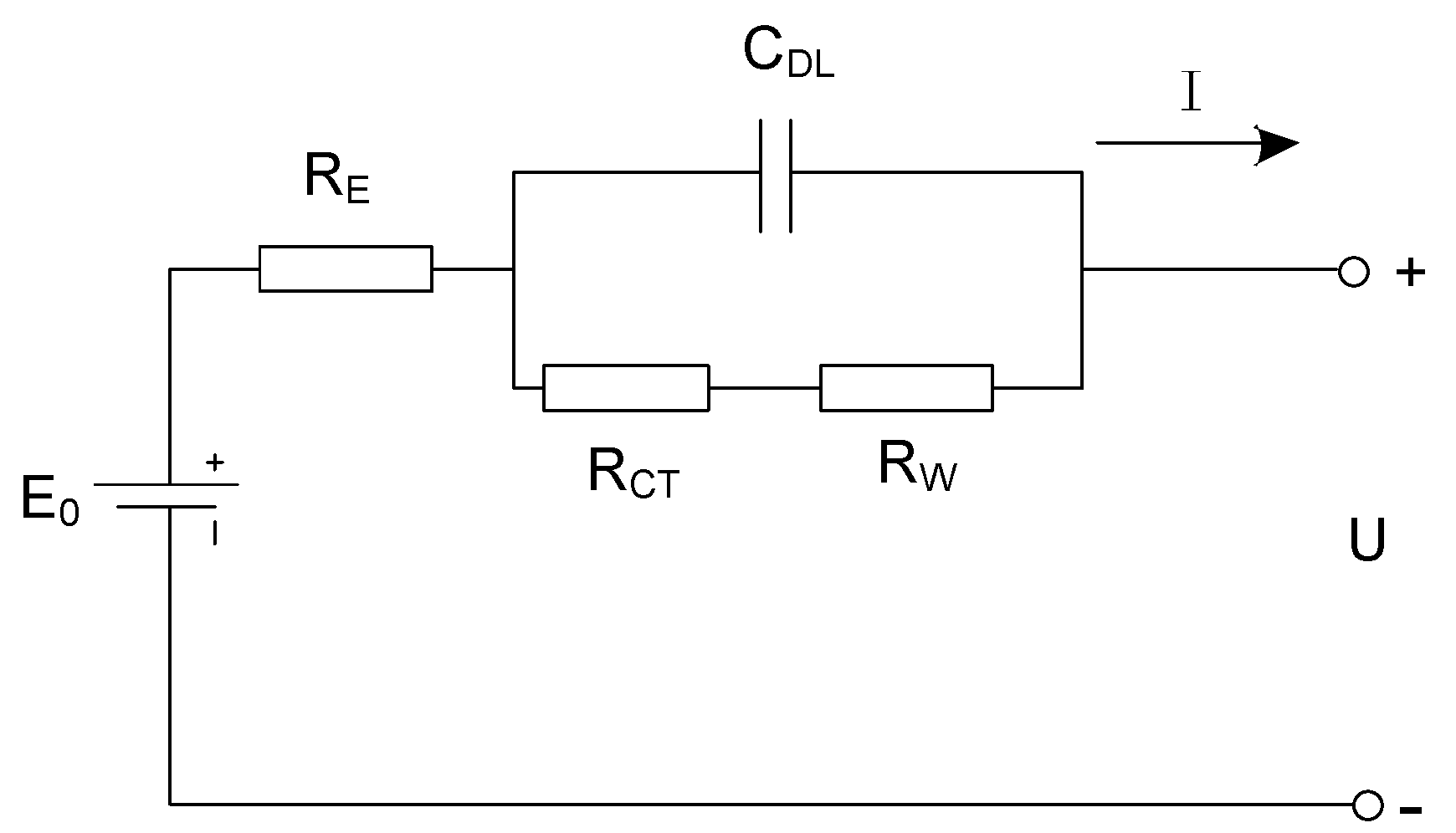
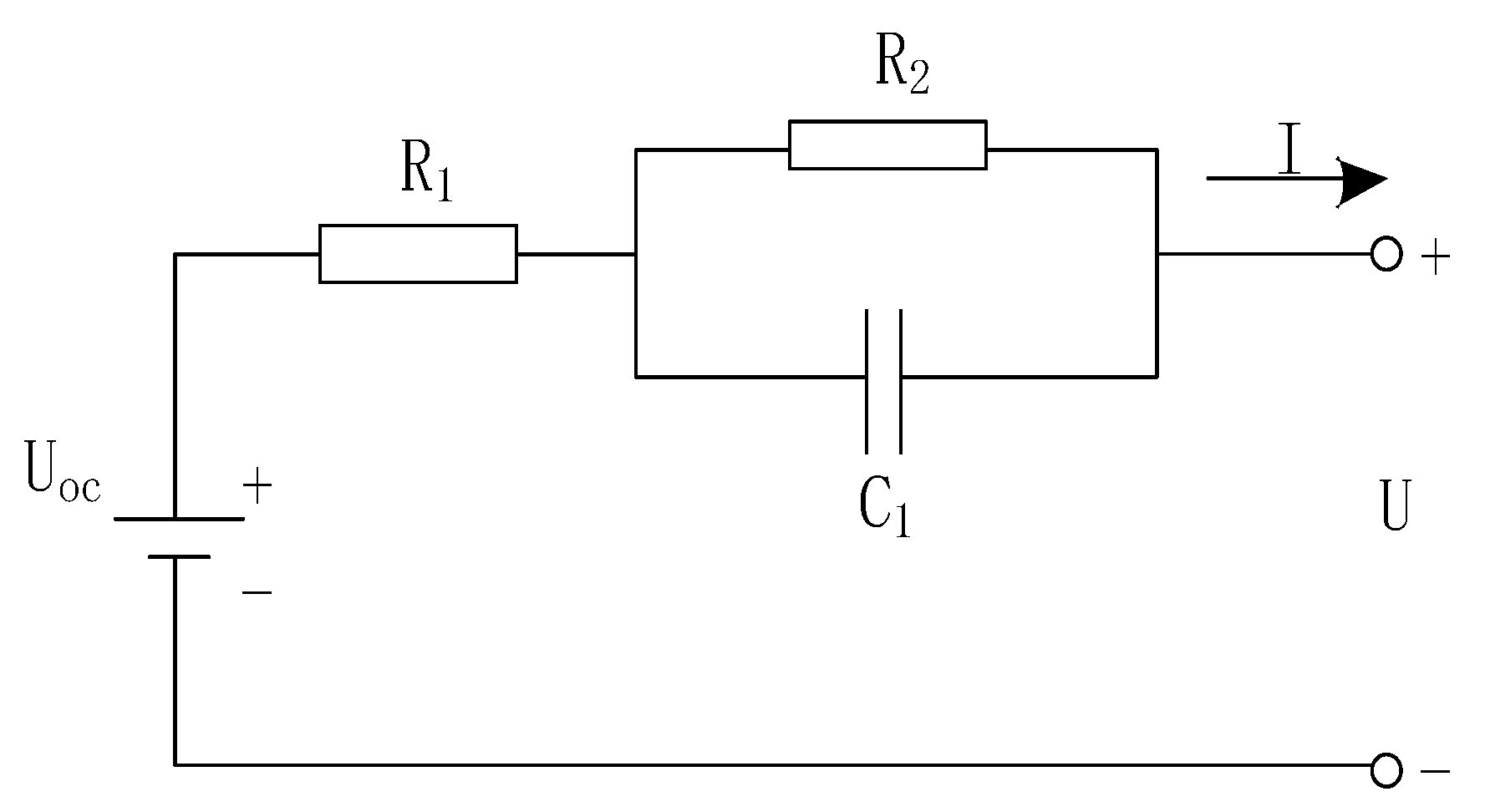


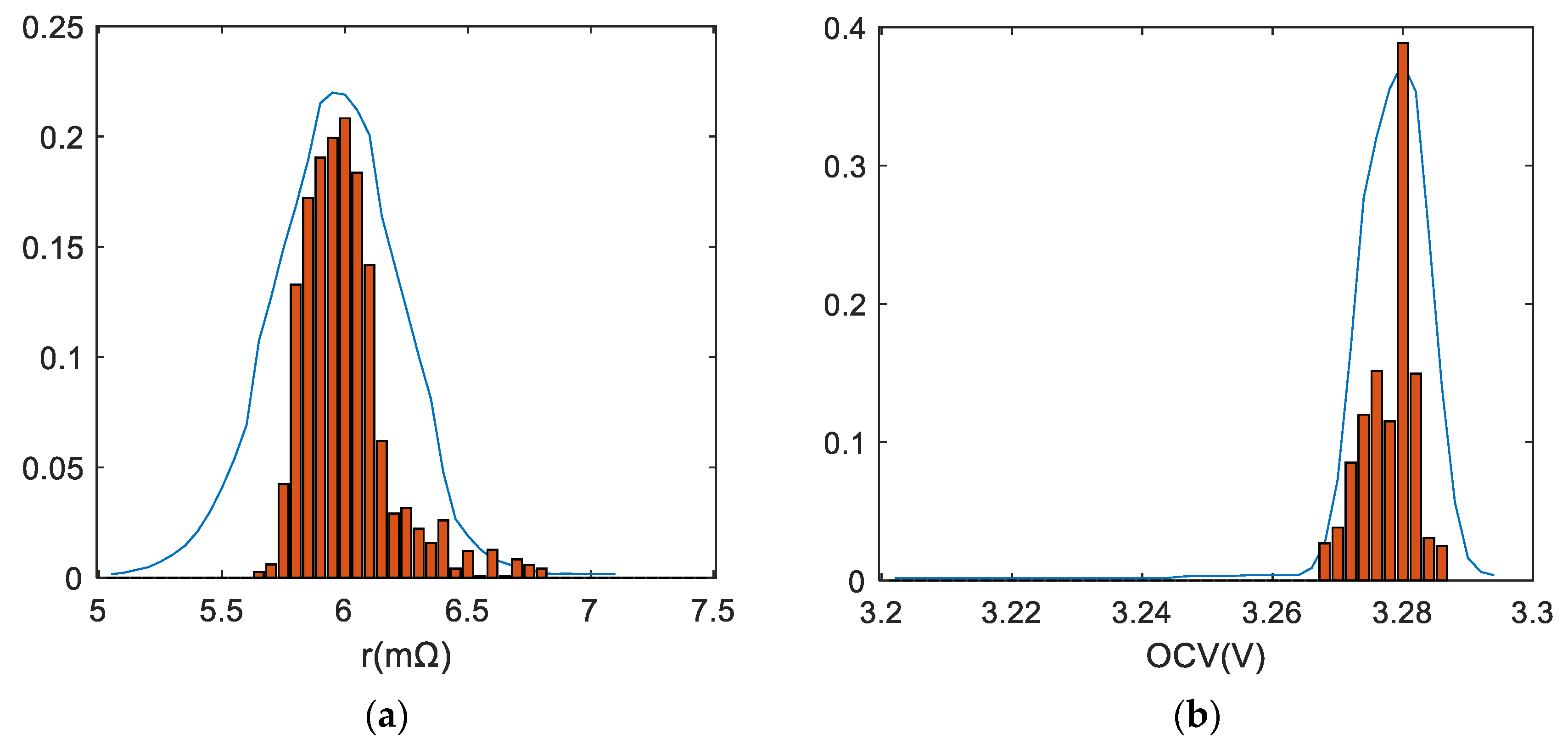



| Method | Advantage | Disadvantages | Direction of Development |
|---|---|---|---|
| Sorting by static parameters | The simplest and most direct method; wide range of application; fast sorting speed. | Measure; cannot reflect battery operating characteristics. | Improve measurement methods and accuracy. |
| Sorting by dynamic parameters | It can partially reflect the characteristics of the battery during operation; compared with static parameter sorting, the accuracy is higher. | It is easy to cause damage to the battery; it can only reflect the parameters of the set working conditions, and it is difficult to determine the actual working parameters. | Dynamic parameters should be as close as possible to the actual situation; reduce the impact of the test on the battery. |
| Sorting by multiple parameters | The sorting accuracy is high; the consideration conditions are more comprehensive. | There are many sorting processes and long-time consumption; it is difficult to achieve large-scale sorting. | Reduce unnecessary processes and improve sorting efficiency. |
| Equivalent circuit model | It can reflect the polarization phenomenon of the battery; the model is simple to establish, and a good model can ensure the sorting accuracy. | It is difficult to fully reflect the battery polarization phenomenon in actual operation. | It is difficult to fully reflect the battery polarization phenomenon in actual operation. |
| Neural network algorithm | No prior knowledge and category information is required; high reliability; wide range of application. | It is easy to fall into the local optimum; the algorithm is not fully applicable and needs to be improved; the complexity is higher. | Improve the algorithm and reduce complexity. |
| Clustering algorithm | Can learn independently; the speed is relatively fast. | High initial parameter requirements; requires a lot of data training. | Improve the model and reduce the number of training to meet the requirements. |
| Statistical algorithm | The requirements on the model are not high; the speed is fast; it is easy to integrate with other methods. | Strict assumptions are required; abnormal parameters are difficult to handle. | |
| Electrochemical parameter analysis | Sorting, according to the battery mechanism and strong persuasion; good applicability; can be applied to large batch sorting. | Electrochemical parameters are difficult to measure; laws are difficult to find. | Try to find a simpler method for measuring electrochemical parameters; look for other electrochemical parameters. |
© 2020 by the authors. Licensee MDPI, Basel, Switzerland. This article is an open access article distributed under the terms and conditions of the Creative Commons Attribution (CC BY) license (http://creativecommons.org/licenses/by/4.0/).
Share and Cite
Li, R.; Zhang, H.; Li, W.; Zhao, X.; Zhou, Y. Toward Group Applications: A Critical Review of the Classification Strategies of Lithium-Ion Batteries. World Electr. Veh. J. 2020, 11, 58. https://doi.org/10.3390/wevj11030058
Li R, Zhang H, Li W, Zhao X, Zhou Y. Toward Group Applications: A Critical Review of the Classification Strategies of Lithium-Ion Batteries. World Electric Vehicle Journal. 2020; 11(3):58. https://doi.org/10.3390/wevj11030058
Chicago/Turabian StyleLi, Ran, Haonian Zhang, Wenrui Li, Xu Zhao, and Yongqin Zhou. 2020. "Toward Group Applications: A Critical Review of the Classification Strategies of Lithium-Ion Batteries" World Electric Vehicle Journal 11, no. 3: 58. https://doi.org/10.3390/wevj11030058








